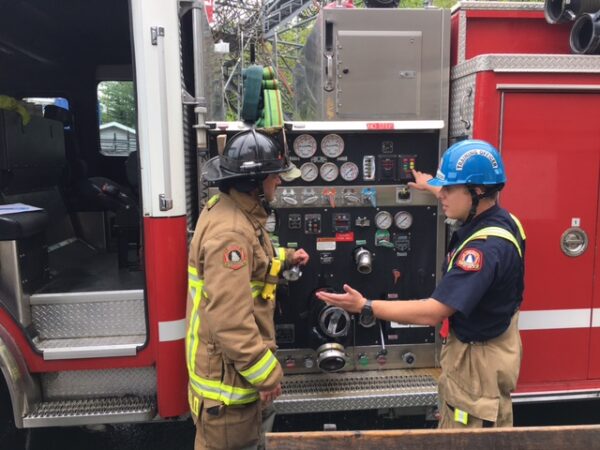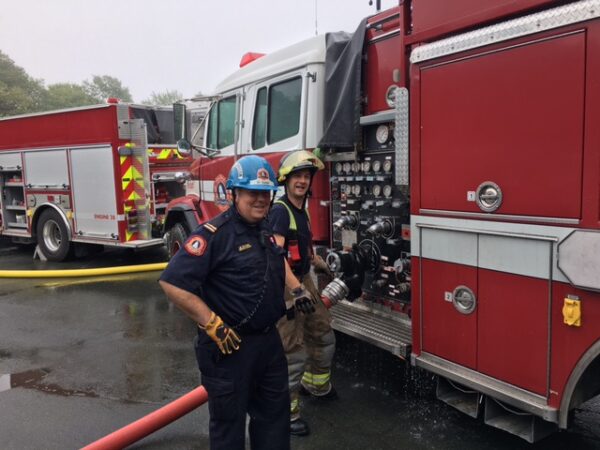
Training your trainers: How Halifax Regional Fire Emergency is keeping their division in check
By Brittani Schroeder
Features Training Week canadian firefighter editors pick firefighter training training Photo credit: Halifax Regional Fire Emergency
Photo credit: Halifax Regional Fire Emergency Halifax firefighter and training officer Trevor Marshall talks trends in firefighter training with Canadian Firefighter’s editor Brittani Schroeder. Read the article or click for audio highlights.
On changing technology and fire fighting tactics:
On incorporating newer equipment:
Trevor Marshall has been working in the Halifax Regional Fire Emergency (HRFE) training division as a training officer for over five years. To this day, he feels like he’s gone back to university because of all the knowledge and experience he’s acquired.
“Vince Conrad, the Division Chief of Training, often sends me around Canada and the U.S. to obtain new tips and tricks in training and bring them back to Halifax to implement. I’ve recently been to Phoenix, Denver, Boston, and Indianapolis for FDIC,” he says. At FDIC, himself, another training officer named Mike Slatter and Chief Conrad sat in on a variety of courses, which helped them identify areas of improvement back in Halifax.
According to Marshall, things in the fire industry are rapidly changing. Attending events help him to bring back new information and tactics so his division can continue to move forward.
“Thankfully, Fire Chief Ken Stuebing, Deputy Chief Corey Beals, and Division Chief Conrad support me in this, because it’s not cheap to be going to all these places regularly.”
From February to July 2023, Marshall worked seven days a week, travelling and instructing on weekends.
Training in Halifax
So, what does the role of a training officer look like at HRFE?
As Marshall describes, he and his team of eight have many things going on every day.
First, recruit training runs in two parallel courses: the career recruitment training (CRT) and the volunteer recruitment training (VRT). “Right now, we have approximately 500 career and 500 volunteer firefighters. We have 51 stations in the Greater Halifax Region, and everyone needs to have the same training foundation,” says Marshall.
The HRFE has had a large recruitment push over the past few years, and have been running spring and fall courses. The typical class size is 20, but this past spring they ran with 25 recruits. Where the CRT runs during the week for 16 weeks, the VRT runs on the weekends for 12 weekends.
The training division runs a program called ADPO, which focuses on driving and pump operations for both career and volunteer members. “We also run aerial and quint training for our trucks with the large ladders on top, and there is specific training for those who work on our fire boat in the harbour.”
Marshall and the training team also host “hot sessions” for their career and volunteer firefighters, and they take six weeks to complete. “We take our firefighters through various scenarios. They come to hone their skills at our training grounds, whether it’s an electric vehicle (EV) extrication piece, or it’s a simulated fire in our search house.”
“We need to knock that fire down as soon as we can to not only preserve life but preserve property.” – Trevor Marshall
These specialty programs run alongside the everyday training for members. One aspect that has become increasingly important in Halifax as the city has developed is how to handle emergencies in high-rise buildings.
“We recently brought out Brent Brooks, a subject matter expert from Toronto, to run a course for us on high-rises. We were looking to create a system on how to deal with these emergencies that works for us in Halifax. Brooks made some quick decisions on things we could probably change for the better, and we’ve worked to incorporate those.”
Another challenge that the HRFE members are often seeing comes from electric vehicles and scooters. “We’ve been training on extrication tactics for these EVs, and we’ve learned that there is a whole different way of tackling battery-powered fires.”

Photo credit: Halifax Regional Fire Emergency
New science, technology and equipment
The world is changing, with great advancements in technology, and HRFE is constantly trying to keep up on the new ways they can tackle these issues, says Marshall.
One thing that has changed over the years is how residential fires burn, and firefighters have had to adapt to that.
“Our typical residential homes are a lot tighter now, so they don’t breathe the same way that older homes do, and the ceilings are much higher, so the dynamics of fighting fires in newer homes has changed a lot from those two perspectives. The contents of homes have also changed—there are a lot more electronic devices now, and those help the fires burn faster,” says Marshall.
Adding on to these faster burns is the fact that houses are made of lightweight construction materials, which means they come down quicker, “sometimes in a timeframe of only seven to eight minutes,” Marshall explains. “This is why we need to train ourselves to be faster and standardize our processes.”
Marshall shares that he and his team have had to train firefighters differently when it comes to residential houses as well, because “kicking out a window won’t work anymore.” Science tells them that kicking out the windows will just feed “the beast”, since oxygen is what it’s looking for. “Tactically, you need to have equipment that can fight the fire, taking into consideration flow path and wind-driven fires.”
They’re also changing tactics on how to move their hoses efficiently in structures, whether it’s commercial, high-rise, or residential.
“Moving the hose deals with personnel. If we run into pinch points, we can’t move any further without dealing with it, so we’re teaching members how to solve that problem and ensure that our nozzle firefighter can move with ease and as quickly as possible. We all know that the quicker we put water on the fire, the quicker the problem goes away.”
Equipment is another piece of the puzzle that is always changing, and a big focus is nozzles and hoses.
At the time of this interview, Marshall just returned from Moncton, where he attended a course run by Aaron Fields, from Seattle, that was called “Nozzle Forward”, where he learned new nozzle techniques.
At HRFE, members are currently working with “combination nozzles, and they can turn into fog nozzles,” says Marshall. He shares that there is now a big push to use smoothbore nozzles, because they are better in defense when firefighters are executing an attack inside a structure.
“The issue here is that any hose we pull off the truck needs to match the pressures of the nozzles we obtain. So, if we bring in new nozzles, which can run over $1,000, we need hoses to match them. New 50-foot hoses also cost over $400, so switching equipment becomes a very pricey task.”
“We hope to provide our captains and firefighters with tools for their tool belt, to be able to attack or resolve any situation that has been presented to them. Having just one thing in your arsenal is not the best; we try to give them as many options as possible to be able to achieve success and ultimately knock a fire out.” – Trevor Marshall
“It’s difficult for the city, because they can’t just say ‘Okay, we’re going to change over all this gear,’ because it would cost millions of dollars. We have to be creative and innovative in how we use our current equipment, and slowly integrate newer pieces within our system when it becomes affordable for us to do so. After Brent Brooks came in for our high-rise training, we bought 25 high-rise bags that, again, aren’t cheap, but our Chief says that if we need something, he will do his darndest to get it so that we’re doing things right.”
Marshall says that people need to remember that these pieces of equipment are a firefighter’s weapons to fight fire.

Photo credit: Halifax Regional Fire Emergency
Standardization
The HRFE and the training division aim to standardize all their processes for their members in the coming years. “Chief Stuebing is pushing us to bring in standardization, because ultimately it means that we will get out to our calls quicker.”
With standardization comes certifications, so the training division runs courses—like leadership and fire officers’ courses—that are then certified by a third party. “We used to run these courses internally, but at the end of the day, for liability and insurance purposes, it’s best to be Pro-Board Accredited.”
The HRFE is also standardizing to make sure all members are using the same language and processes at each of their 51 stations. They’ve also shared this with nine agency departments who are on the outskirts of the Greater Halifax Area so that, when they arrive on scene to tackle a fire together, they’re on the same page.
Chief Stuebing also wants the fire department to be accredited. The accreditation essentially says that every program that the fire department runs is standardized. “For example, this would mean from truck to truck, no matter the station, all the cabinets would be set up the same way. How we deploy our hoses off the truck, we’d all do it the same way. So, if a firefighter showed up at station 18, they’d pull a hose off the truck the same way they do at station 38. This accreditation standardizes processes across all divisions, which would bring in continuity and ensure we all follow the criteria of data that was collected by analytics and then documented and formulated for us to refer to and follow in the future,” says Marshall.
All in a day’s work
Trevor Marshall is really into sports, and he says that firefighting is related to sport in many ways. However, he says that there is one major difference between the two. “In hockey, you change shifts; in soccer and basketball, you can substitute a player. With firefighting, you get one crew to show up on scene and do a task, and another crew shows up for another task. Everyone is working together to achieve the overall goal of knocking the fire down. We all have to be in sync, and there are no immediate substitutions. We all need to work cohesively to achieve this one goal, quickly and safely. This is where training and standardization is so important.”
Print this page